Introduction
Media and entertainment face pressure to deliver high-quality, personalized content at scale, under tight budgets and compressing production timelines. Artificial Intelligence (AI) is rapidly emerging as the game-changing force – automating creative workflows, enhancing monetization, and unlocking new storytelling possibilities. This guide explores how AI is transforming the industry and what it means for decision-makers and content professionals.
As AI continues to redefine content creation, personalization, and production in media and entertainment, the real value emerges when these innovations are seamlessly integrated into scalable, real-world solutions. For organizations looking to accelerate digital transformation and creative agility, discover how AI-assisted software development can help turn cutting-edge ideas into impactful business results.
What is AI and Why Does It Matter in Media and Entertainment?
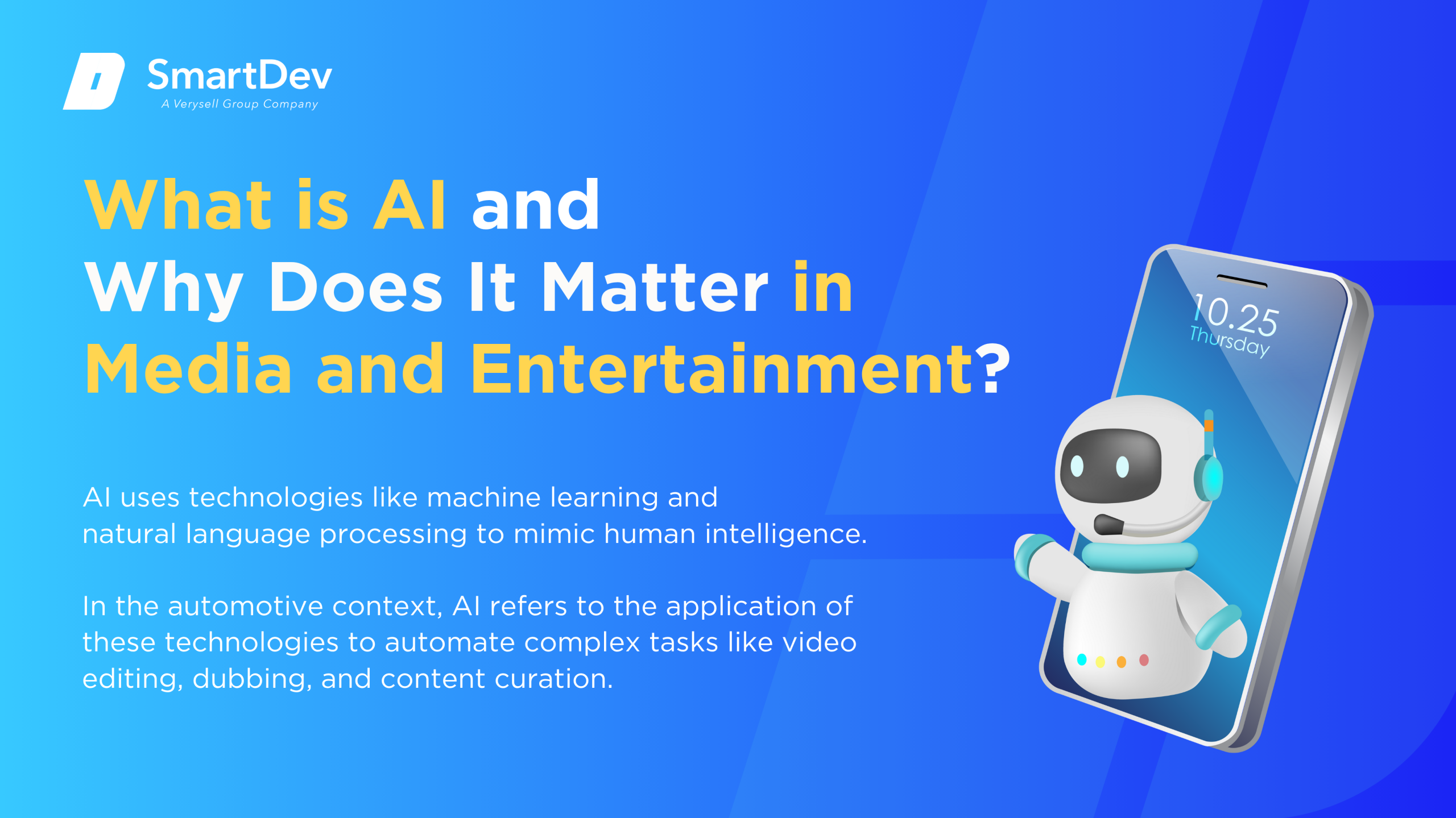
Definition of AI and Its Core Technologies
Artificial Intelligence (AI) refers to computer systems capable of tasks that normally require human intelligence – learning, reasoning, generating content, and decision‑making – using methods like machine learning, natural language processing (NLP), and computer vision.
In media and entertainment, AI technologies automate complex tasks like video editing, dubbing, and content curation. They also power innovations such as personalized recommendations, synthetic media generation, and real-time translation to enhance both production efficiency and viewer engagement.
The Growing Role of AI in Transforming Media and Entertainment
AI is rapidly becoming foundational across the media and entertainment ecosystem. From pre-production to post-release, it is transforming how content is conceived, created, and consumed. Whether through script generation, automated editing, or audience targeting, AI is deeply integrated into daily workflows across studios, broadcasters, and digital platforms.
Streaming services like Netflix and Disney+ use machine learning to drive hyper-personalized content recommendations, directly influencing viewer retention and engagement. At the same time, sports broadcasters are embracing AI to generate real-time highlights and even revive iconic voices using synthetic voice technology. These tools not only enhance the viewer experience but also reduce turnaround time for content delivery.
AI’s impact is especially clear in editing and production speed. Tools like Moments Lab’s MXT‑2 can index and clip video content up to seven times faster than manual methods, supporting media giants like Warner Bros, Discovery and Hearst. As demand for rapid, high-volume content grows, AI is redefining what’s possible in terms of scale, efficiency, and creative agility.
Key Statistics and Trends Highlighting AI Adoption in Media and Entertainment
AI adoption in media and entertainment is accelerating rapidly, with the global market expected to grow from $19.8 billion in 2024 to $123.5 billion by 2033, at a CAGR of 22.6%. North America currently leads the sector with a 38% market share, while Asia-Pacific is the fastest-growing region. This growth is driven by AI’s role in automating workflows, enhancing personalization, and reducing production costs.
Generative AI has seen sharp adoption, rising from 33% to 71% usage among organizations between 2022 and 2024. Meanwhile, AI already influences around 69% of global ad revenue, with projections hitting 94% by 2029. These trends highlight a deepening reliance on AI to scale content production and monetization strategies.
Business Benefits of AI in Media and Entertainment
AI is solving some of the most pressing challenges in media and entertainment – streamlining operations, cutting costs, and enabling more dynamic audience engagement. Below are five core benefits driving adoption across the industry.
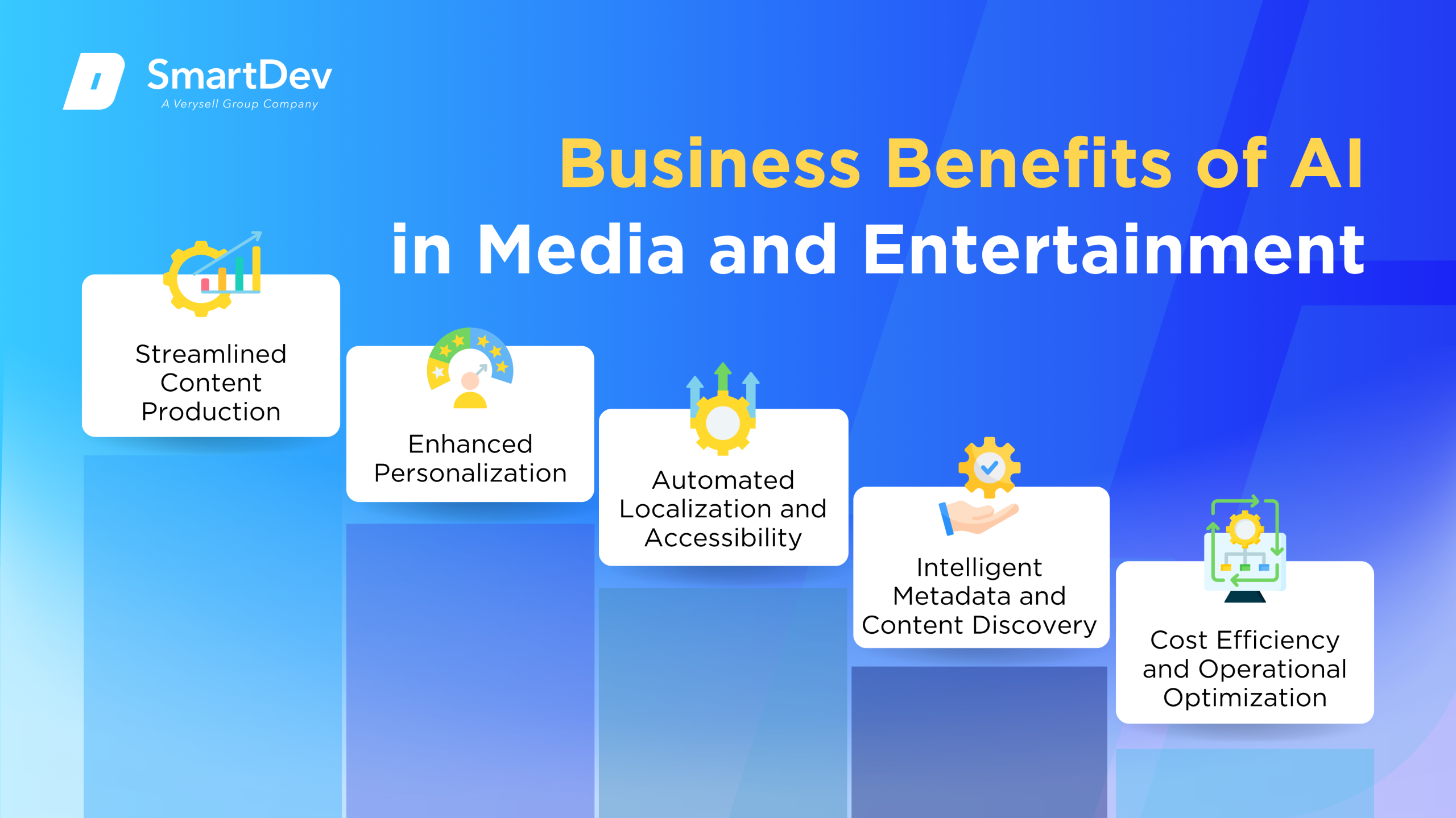
1. Streamlined Content Production
AI automates time-intensive tasks such as editing, tagging, and scene recognition, allowing teams to produce content faster with fewer resources. This significantly shortens production timelines, especially for high-volume or fast-turnaround formats.
By handling repetitive functions, AI frees creative professionals to focus on high-value work, enhancing both productivity and content quality. It also reduces dependency on large production crews or extended post-production phases.
2. Enhanced Personalization
Machine learning algorithms analyze user behavior to deliver highly personalized content recommendations. This improves user retention by keeping audiences engaged with relevant content tailored to their preferences.
Personalization also extends to marketing and advertising, enabling platforms to present users with promotions or messages that align with their viewing habits. The result is improved engagement and higher conversion rates.
3. Automated Localization and Accessibility
AI-driven translation and dubbing tools enable rapid localization of content for global audiences. This allows platforms to scale international distribution without the cost and time associated with manual processes.
Accessibility features such as automatic captioning and voice-to-text improve compliance and expand reach to underserved audiences. These tools make content more inclusive while supporting legal and regional standards.
4. Intelligent Metadata and Content Discovery
AI automatically generates metadata such as keywords, scene descriptions, and content summaries, improving content searchability and discoverability. This allows platforms to organize large libraries more efficiently and connect users with relevant material.
Improved metadata also supports internal analytics, making it easier to track performance trends and inform programming decisions. In turn, this enhances content strategy and overall catalog value.
Dive into our case study on AI-Driven Engagement Platform for a Journalism Marketplace to see how AI solutions can enhance content discovery and engagement through smart tagging and NLP.
5. Cost Efficiency and Operational Optimization
AI reduces operational costs by automating workflows that would traditionally require manual labor. These efficiencies are especially valuable in areas like editing, asset management, and quality control.
Over time, AI tools can scale operations without proportionally increasing headcount or infrastructure costs. This makes it easier for organizations to adapt to market demand while maintaining profitability.
Challenges Facing AI Adoption in Media and Entertainment
While AI offers powerful benefits, its implementation is far from seamless. Below are five key challenges that companies must navigate to adopt AI effectively and responsibly.
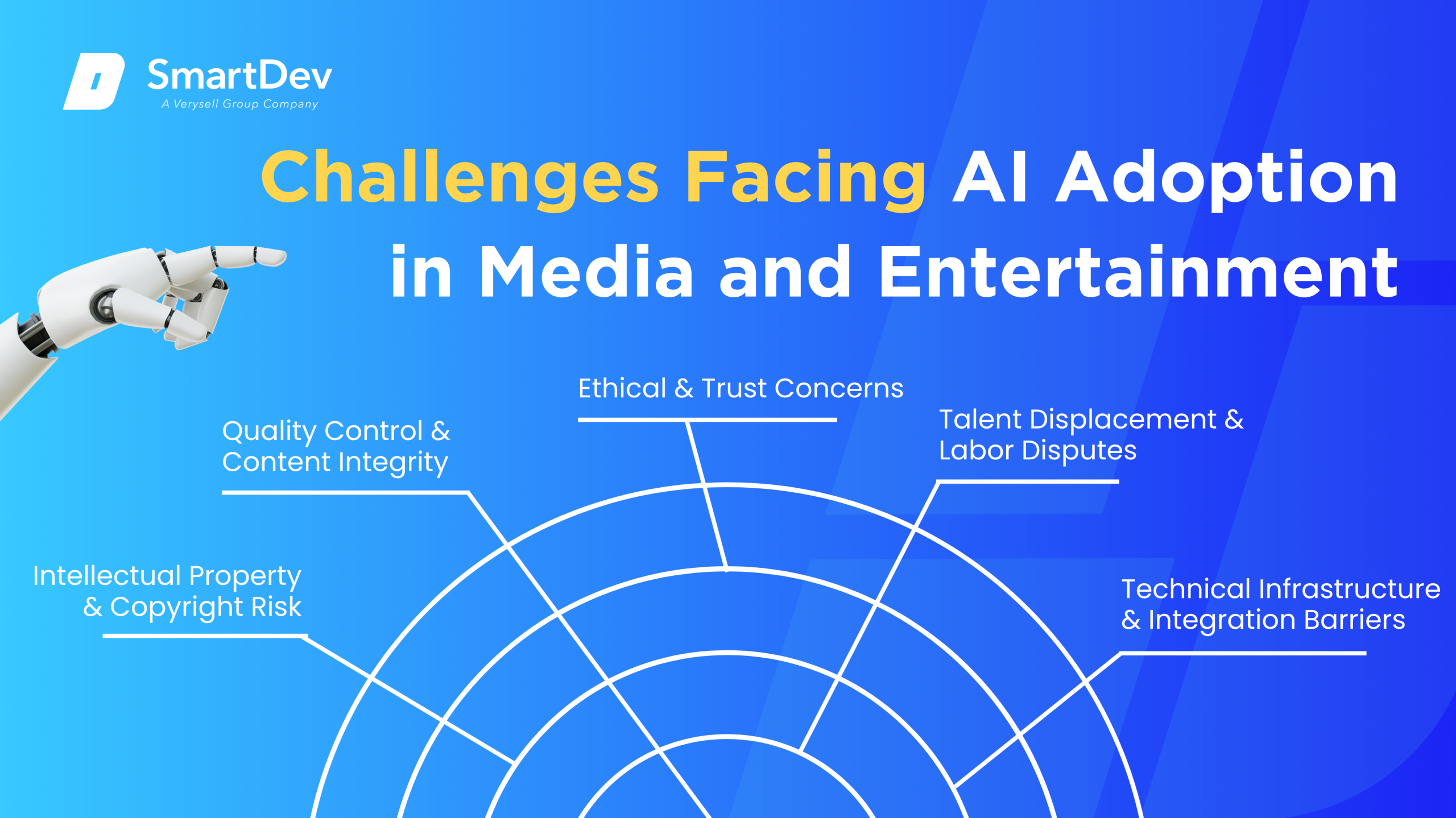
1. Intellectual Property and Copyright Risk
Training AI models often involves using copyrighted materials – scripts, audio, and footage – raising legal and ethical concerns. Without explicit permissions or licensing frameworks, companies risk litigation and reputational damage.
This creates uncertainty around how AI-generated content can be commercialized or distributed, slowing adoption across production environments. Organizations must balance innovation with legal compliance.
2. Quality Control and Content Integrity
AI-generated outputs, especially in visual and narrative formats, can suffer from inconsistencies or inaccuracies. Whether it’s disjointed dialogue or unnatural visuals, quality lapses can compromise viewer trust.
Maintaining a human-in-the-loop approach is essential to ensure creative standards and brand integrity are upheld. AI can support, but not fully replace, human judgment in content creation.
3. Ethical and Audience Trust Concerns
Synthetic media, such as deepfake voices or avatars, can blur the line between tribute and manipulation. Without transparent usage disclosures, audiences may feel misled or uncomfortable.
This raises broader ethical questions around consent, representation, and emotional authenticity. Clear guidelines and communication are necessary to retain viewer trust and respect audience sensitivities.
4. Talent Displacement and Labor Disputes
As AI automates roles in editing, localization, and writing, fears of job loss are intensifying across creative sectors. These concerns have already fueled pushback from industry unions and professionals.
Tensions around fair credit, compensation, and control over AI outputs are creating friction during adoption. Companies must address these concerns to ensure sustainable integration.
5. Technical Infrastructure and Integration Barriers
Deploying AI at scale requires robust data infrastructure, cloud computing capabilities, and seamless system integration. Many legacy production environments lack the technical foundation for AI implementation.
This creates significant upfront investment needs – both in technology and workforce training – which can be a barrier for small to mid-sized studios. Strategic planning and phased rollouts are critical to managing costs and complexity.
Specific Applications of AI in Media and Entertainment
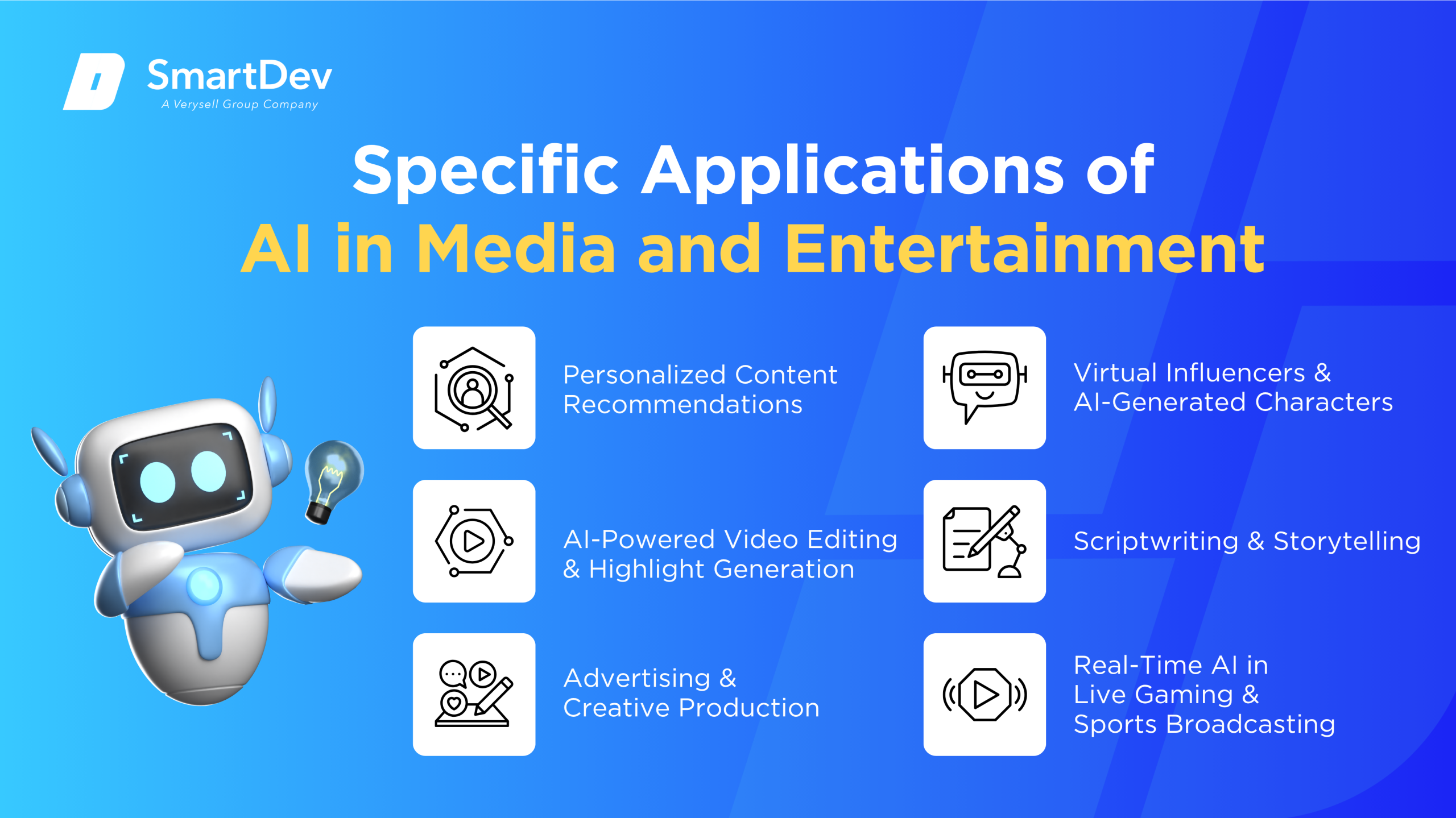
1. Personalized Content Recommendations
AI-powered recommendation systems help streaming platforms and media services cut through content overload by tailoring suggestions to each user’s behavior. They analyze vast datasets – viewing habits, ratings, search history, session times, and metadata – using collaborative filtering and deep learning to predict what users will enjoy.
These systems integrate seamlessly within user interfaces, updating recommendations in real time as users interact. They require robust data pipelines, model retraining, and privacy safeguards to adhere to data regulations. Strategically, they reduce churn and personalize experiences at scale, but they must manage bias and avoid creating echo chambers.
Despite privacy concerns, transparent opt-ins and anonymized data help strike a balance. Bias mitigation (e.g., on regional content) and continuous model tuning are critical. Ultimately, these systems offer efficiency, personalization, and significant ROI.
Real-World Example: Netflix employs its AI recommendation engine – analyzing user watch history, searches, and engagement – to personalize home screens. Powered by deep learning models built on member data, it’s credited with saving Netflix around $1 billion annually. This personalization contributed to Netflix reaching 260 million paid subscribers by Q4 2024.
Explore how AI shapes personalized customer experiences in our article on AI-powered virtual assistants.
2. AI-Powered Video Editing & Highlight Generation
Automated editing tools index raw footage using computer vision, audio analysis, and transcript data to identify key moments. By applying scene detection, audio sentiment, and keyword tagging, these systems generate highlight reels, trailers, and clips without manual effort. This speeds up production workflows, enabling media teams to produce highlights seven times faster and double social media revenue.
Integration into editing suites (e.g., Adobe Premiere) allows editors to refine AI-generated suggestions, ensuring creative control and final polish. However, these tools require quality metadata, robust training data, and scalable architectures to avoid biases and misidentifying important moments. Ethically, AI aids editors but need checks to prevent overreliance and preserve creative judgment.
Operationally, it slashes labor costs and supports rapid content repurposing across platforms. It also raises questions about IP, licensing, and the role of human oversight. The value lies in speed, consistency, and extended content reach.
Real-World Example: Moments Lab’s MXT‑2 uses multimodal AI to index footage and produce highlight reels up to 7x faster, helping clients like Warner Bros Discovery and Hearst increase social media revenue two-fold. The tool ingests video, audio, and metadata, generating clips ready for manual refinement. This drastically reduces editing time and accelerates content distribution.
3. Generative AI for Advertising & Creative Production
Generative AI transforms ad creation by drafting visuals, copy, and storyboards from text prompts. Leveraging GANs, transformers, and multimodal models, it helps marketers ideate and iterate quickly. The system digs into brand assets and trend data to maintain consistency across channels.
It integrates with ad platforms and design tools to auto-generate variants for A/B testing, reducing time and cost in campaign development. Key considerations include training data quality, brand alignment, and compliance with copyright standards. Organizations must balance creative freedom with content authenticity.
This drives strategic value through faster iteration cycles, enhanced targeting, and greater return on ad spend. Ethical concerns include creative homogenization and AI dependency, requiring human oversight. Despite this, the ROI appears compelling enough to spur fast adoption.
Real-World Example: WPP leveraged AI to produce a Super Bowl commercial in-house, using its WPP Open platform and acquired AI startups to automate creative tasks. The project slashed production costs and expedited timelines considerably. It illustrates generative AI’s ability to deliver high-profile, brand-safe advertising content at scale.
Dive deeper into AI-powered marketing with our article on redefining campaign performance with AI.
4. Virtual Influencers & AI-Generated Characters
Virtual influencers are synthetic personas powered by AI – visual generation, voice synthesis, and scripted interaction. They appear on social platforms, modeling brands and engaging fans around the clock. These digital avatars offer brands total control over content, brand safety, and availability.
They rely on CGI, generative models, and AI-driven responses to mimic human behavior. Key technical needs include lifelike visuals, scalable dialogue systems, and persona management. Ethically, transparency is vital users must know if they’re interacting with an AI.
This opens new marketing channels and revenue streams, enhancing brand storytelling. Virtual influencers deliver cost-efficient engagement but raise concerns about authenticity, consent, and job displacement. Firms using them must establish ethical guardrails.
Real-World Example: Aitana López, created by The Clueless, is a virtual influencer with over 250k Instagram followers, earning approximately €10k monthly. Built using CGI and AI persona tools, she partners with major brands and blurs the line between digital and human influencers. Her popularity showcases the commercial potential of virtual personas.
5. AI in Scriptwriting and Storytelling
Generative AI aids writers by producing outlines, character arcs, dialogue snippets, and scene descriptions. Models like GPT‑4 or Claude analyze story structures and genre conventions, offering ideas to overcome creative blocks. This accelerates the ideation phase and supports writer collaboration.
These tools ingest training data – scripts, story bibles, character sheets – and produce drafts for human refinement. Writers integrate prompts into their workflows to jumpstart plots or test dialogue options. They must manage quality control, originality, and potential copyright concerns.
Strategically, AI boosts productivity and supports diverse creative voices. Yet ethical considerations around authorship, bias, and de-skilling require careful oversight. When used responsibly, AI enriches, not replaces, the writing process.
Real-World Example: Studios use tools like ScriptBook and ChatGPT to predict script success and generate drafts. ScriptBook analyzes plot structure and character dynamics to estimate box office potential. Meanwhile, ChatGPT and Jasper help writers iterate faster, reducing draft time and enhancing creativity.
Learn about different AI model types and how to choose the right one for creative tasks in our detailed guide about AI model.
6. Real-Time AI in Live Gaming & Sports Broadcasting
AI enhances live events by providing real-time commentary, dynamic NPC interactions, and immersive analytics. Tools analyze live data feeds – stats, events, audio, video – to generate contextual insights, commentary, and game adjustments. This enriches viewer/player engagement with personalized, data-driven content.
In gaming, conversational agents (like NPCs) respond intelligently, driven by voice models and real-time data. In broadcasting, AI delivers fast analytics and narrative overlays. Challenges involve ensuring accuracy, maintaining tone, and avoiding disruptive errors live.
Operational advantages include scalable, engaging experiences and new monetization paths. However, oversight and error-checking remain essential. Effectiveness hinges on balancing real-time insight with creative quality.
Real-World Example: Warner Bros Discovery partnered with AWS to launch “Cycling Central Intelligence,” an AI platform that generates live insights during mountain bike races. Built on AWS Bedrock with Claude 3.5, it delivers real-time stats and narrative to fans. Meanwhile, Fortnite features AI-powered Darth Vader NPCs using voice synthesis, boosting player immersion.
Need Expert Help Turning Ideas Into Scalable Products?
Partner with SmartDev to accelerate your software development journey — from MVPs to enterprise systems.
Book a free consultation with our tech experts today.
Let’s Build TogetherExamples of AI in Media and Entertainment
AI is no longer a future concept in media and entertainment, it’s already driving some of the industry’s most successful innovations. The following real-world examples highlight how leading companies are using AI to enhance personalization, streamline creative production, and deepen audience engagement.
Real-World Case Studies
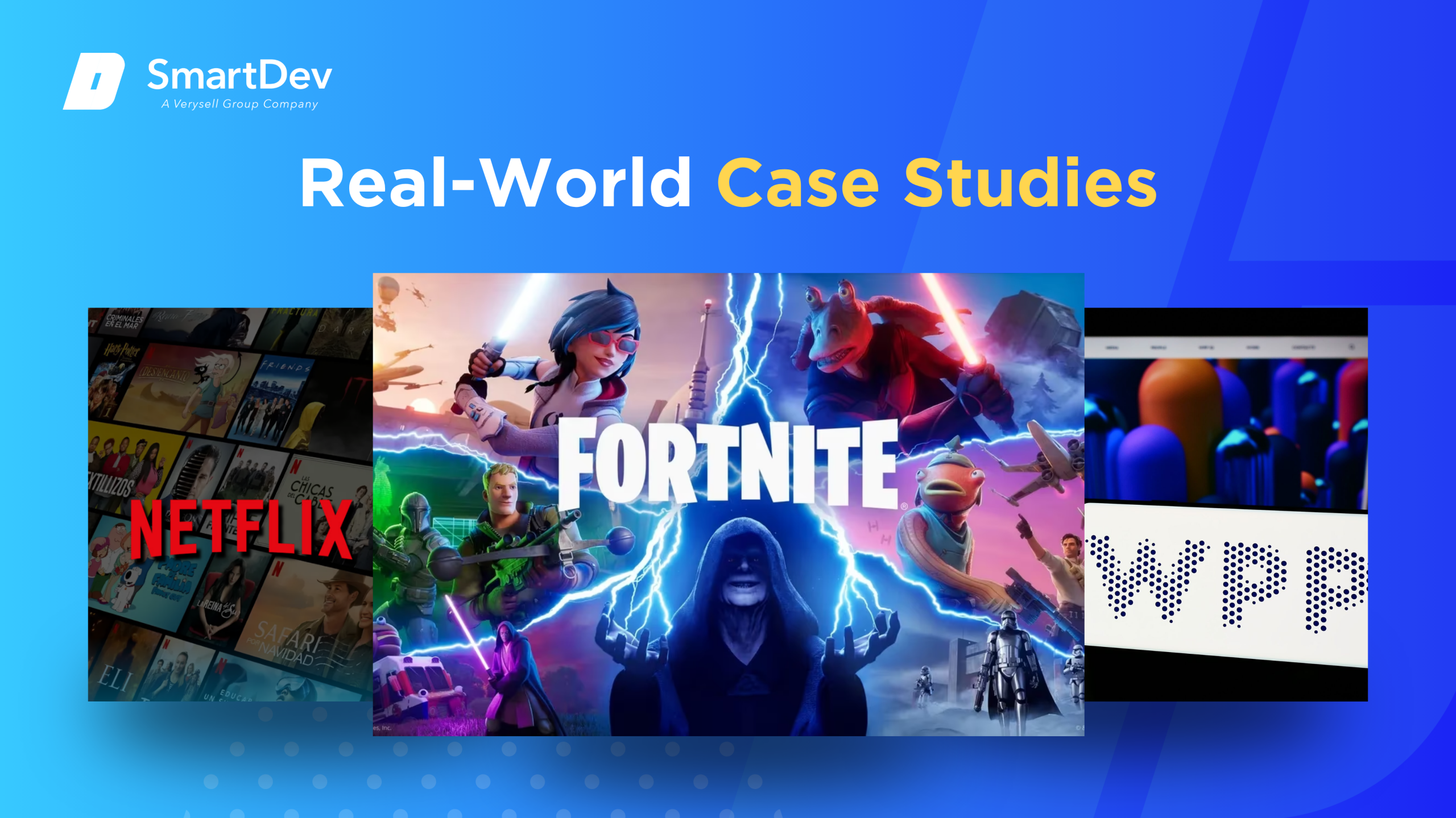
1. Netflix: Personalized Recommendation Engine
Netflix’s AI-driven recommendation system is one of the most widely known and effective applications of AI in media. Using algorithms such as matrix factorization, deep learning, and reinforcement learning, Netflix processes user watch history, time of day, and device type to deliver personalized content suggestions. This system is credited with driving over 80% of viewer activity and saving Netflix approximately $1 billion per year by reducing churn and improving user satisfaction.
Netflix’s system continuously learns and adapts through A/B testing and real-time feedback loops, optimizing for engagement and retention. It also integrates visual metadata, such as thumbnails that change per user, to increase click-through rates. This powerful blend of AI personalization and UI optimization has helped Netflix retain over 260 million global subscribers, making it the benchmark for AI in streaming services.
2. WPP: Generative AI for Ad Campaign Production
Global marketing giant WPP leveraged generative AI to create an in-house Super Bowl ad, showcasing the transformative power of AI in high-stakes creative environments. By using its proprietary platform WPP Open, the firm incorporated image generation, voice synthesis, and prompt-driven content design to dramatically reduce ad production time and cost. This approach enabled real-time adjustments and multiple campaign iterations – traditionally a lengthy and expensive process.
WPP’s success with generative AI demonstrates how agencies can scale creativity without sacrificing brand voice or quality. It also highlights the competitive advantage of integrating AI directly into creative workflows, enabling agile responses to market trends. As clients demand faster turnarounds and personalized messaging, generative AI becomes central to modern advertising strategies.
3. Epic Games: AI NPCs in Fortnite
Epic Games has pushed the boundaries of interactive entertainment by introducing AI-powered non-player characters (NPCs) in Fortnite. One standout example is the Darth Vader character, which uses voice synthesis technology (based on James Earl Jones’ vocal) and real-time conversational AI to create emotionally responsive gameplay. This brings cinematic quality into live gameplay environments and boosts user immersion.
The AI NPCs are not only interactive but also capable of learning and adapting to player behavior, making each game session unique. This innovation has increased Fortnite’s average session time and user engagement metrics, contributing to the platform’s sustained popularity. Epic’s collaboration with Disney and Lucasfilm marks a significant step in merging AI, gaming, and storytelling.
Innovative AI Solutions
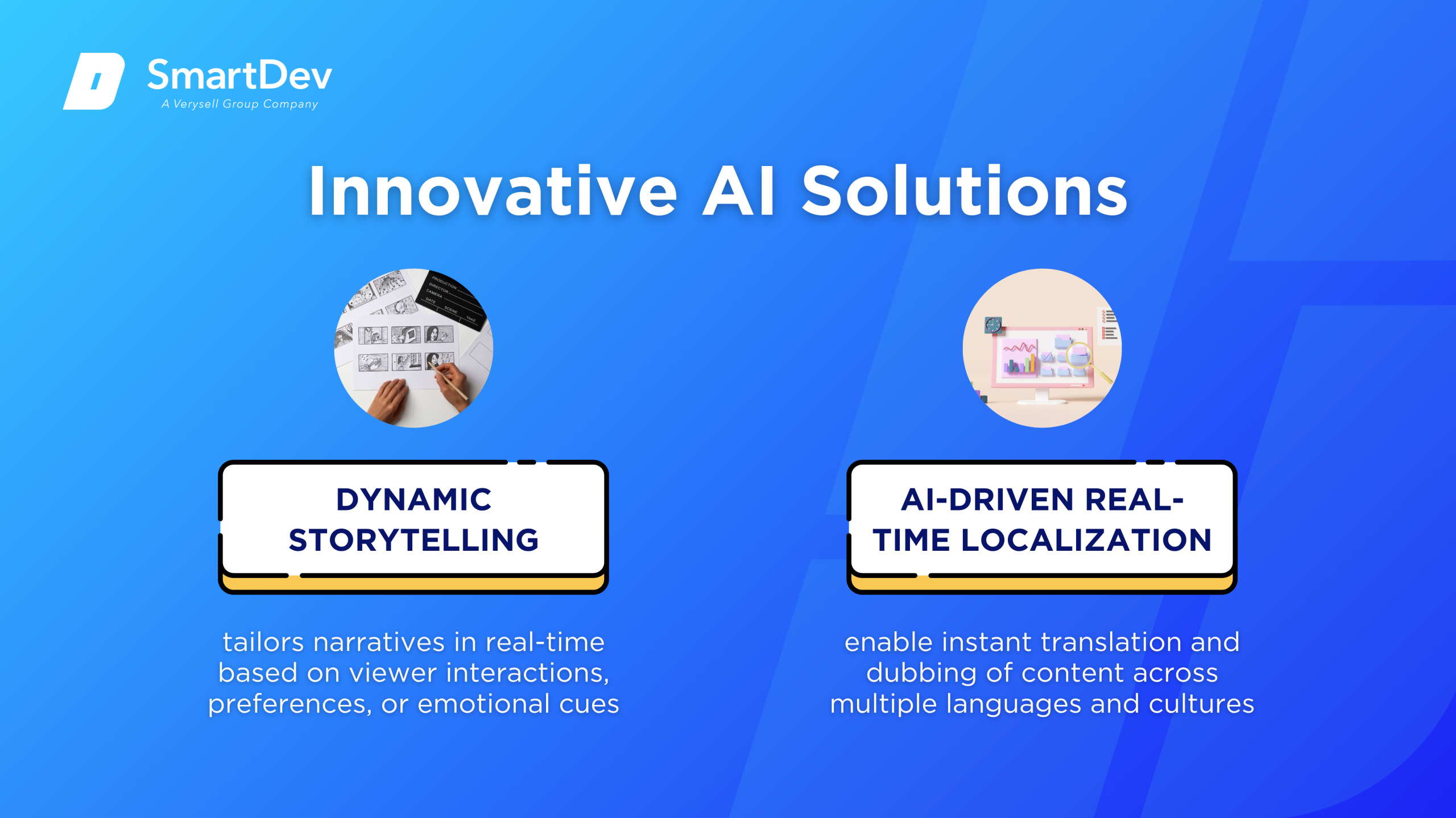
Innovative AI technologies are rapidly reshaping how media and entertainment content is created, distributed, and consumed. One key development is dynamic storytelling, where AI tailors narratives in real-time based on viewer interactions, preferences, or emotional cues. This approach is being explored in interactive films, games, and virtual reality experiences, offering a personalized and immersive journey for every user.
Another emerging area is AI-driven real-time localization, enabling instant translation and dubbing of content across multiple languages and cultures. Tools combining speech synthesis, lip-syncing, and machine translation are reducing post-production time while expanding global reach. These solutions not only accelerate international distribution but also make content more inclusive and accessible to diverse audiences.
To see how AI agents are already revolutionizing real-world industries beyond media, explore our guide on real-world applications of AI agents.
AI-Driven Innovations Transforming Media and Entertainment
Emerging Technologies in AI for Media and Entertainment
AI is rapidly advancing how content is created, edited, and personalized. Generative AI tools can now assist in developing scripts, producing visual effects, and even generating music, enabling faster and more flexible production cycles. This shift allows creators to focus more on strategy and storytelling while letting AI handle repetitive creative tasks.
Computer vision is another transformative technology, enabling systems to analyze, tag, and organize large volumes of visual content with remarkable accuracy. These tools support everything from automated editing to dynamic scene recognition, enhancing efficiency and consistency. As media formats diversify across platforms, AI helps streamline content adaptation without compromising quality.
AI’s Role in Sustainability Efforts
AI contributes significantly to making media and entertainment operations more sustainable. Through predictive analytics, companies can better forecast resource needs, reducing unnecessary production waste and energy consumption. These efficiencies support both environmental goals and operational cost savings.
Smart systems powered by AI also enable real-time monitoring and management of energy usage in studios and broadcasting environments. From lighting controls to server optimization, AI-driven automation ensures that sustainability targets are met without sacrificing performance. This integration aligns corporate responsibility with technological innovation.
How to Implement AI in Media and Entertainment
Implementing AI in media and entertainment requires more than just adopting new technology, it demands a clear, structured approach. The following guide outlines how organizations can effectively integrate AI into their operations to achieve measurable results and long-term scalability.
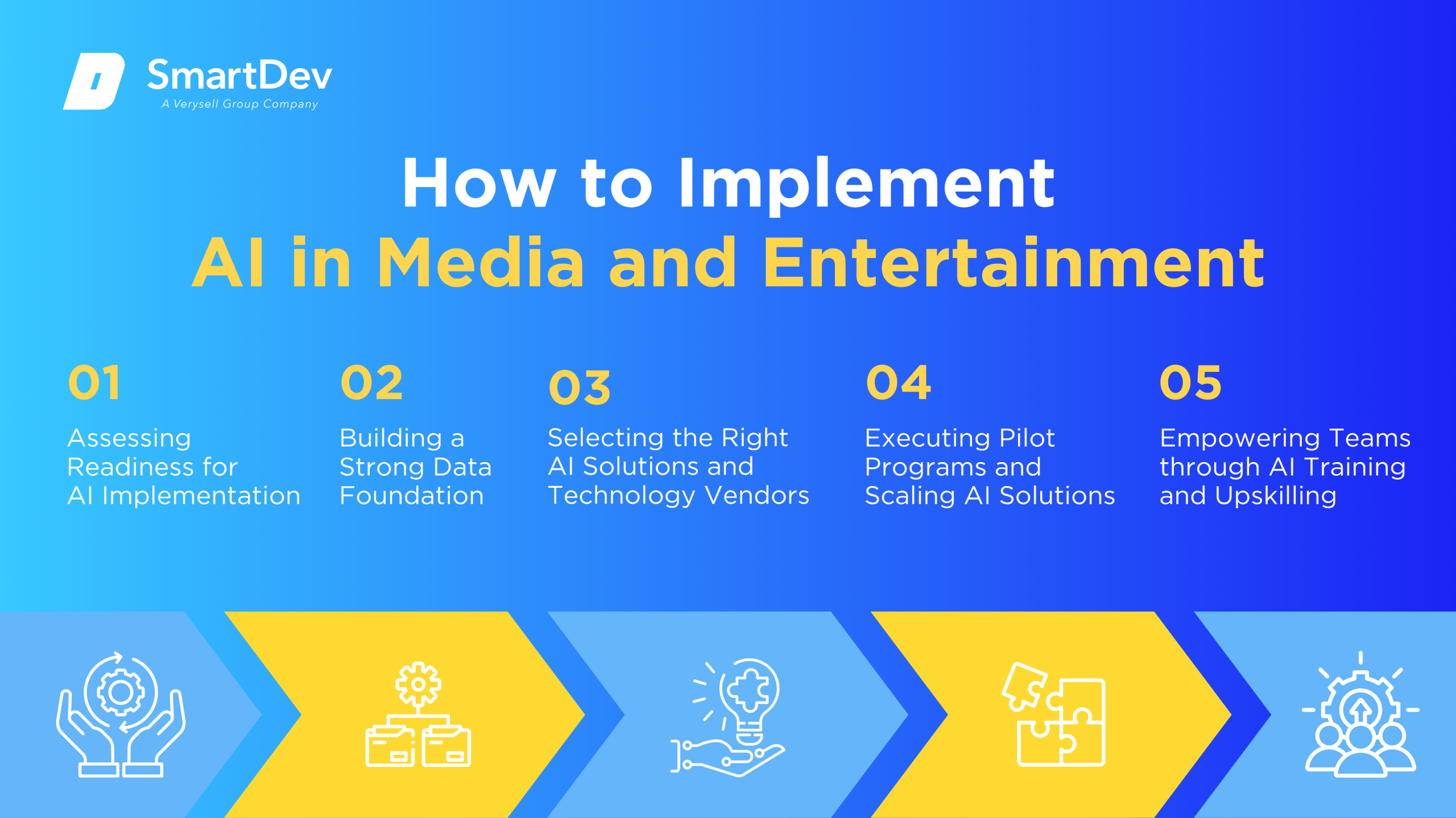
Step 1: Assessing Readiness for AI Adoption
Before diving into AI, it’s important to evaluate where your organization stands in terms of digital maturity. Start by identifying processes that rely heavily on manual input or repetitive tasks, such as editing, tagging, or campaign planning. These areas often provide the best starting points for AI integration because they offer measurable results with minimal disruption.
You should also assess leadership support and internal openness to change. AI implementation involves a cultural shift that may challenge traditional creative processes. Without buy-in from decision-makers and key teams, even the most advanced solutions can fail to gain traction.
Step 2: Building a Strong Data Foundation
Effective AI relies on clean, accessible, and structured data. Media organizations need to collect consistent metadata from assets, including visual files, audio tracks, and performance analytics. This foundation allows AI tools to work efficiently and produce accurate outputs.
Creating a centralized data system ensures that different departments can access and use the same information. Data governance should also be a top priority to maintain accuracy, compliance, and security. When your data is reliable, your AI models become more trustworthy and scalable.
For a deeper look at how effective data management supports smarter decision-making and long-term growth, explore our article on data-driven success in small business growth.
Step 3: Choosing the Right Tools and Vendors
Selecting the right AI tools is not just a matter of features but also of strategic alignment. Look for vendors who understand the nuances of media workflows and can offer tailored solutions that support your creative and business goals. Ensure the technology integrates smoothly with your current systems and can scale as your needs grow.
Vendor transparency is just as critical as functionality. Make sure you understand how the tool handles your data, especially when it comes to content ownership and intellectual property. A reliable partner should provide clear terms, support, and regular updates to keep pace with the evolving media landscape.
Step 4: Pilot Testing and Scaling Up
Piloting AI in targeted, low-risk areas allows you to demonstrate value while minimizing disruption. Whether enhancing trailer production or automating content tagging, small-scale experiments help refine your approach and expose practical challenges. These early wins are critical for building organizational confidence and securing broader buy-in.
Use the results of your pilot to refine your strategy. Analyze performance metrics, gather team feedback, and adjust workflows as needed. Once you demonstrate success at a small scale, expanding becomes more straightforward and justifiable.
Step 5: Training Teams for Successful Implementation
Equip teams with the skills needed to work effectively with AI systems. Provide training on specific tools and highlight how AI supports rather than replaces creative functions. Practical knowledge helps ease the transition and increases tool adoption.
Encourage collaboration between technical and creative teams. Integration is most effective when AI complements human expertise in structured, predictable workflows. A well-trained workforce ensures consistent, reliable use of AI across the organization.
Measuring the ROI of AI in Media and Entertainment
Key Metrics to Track Success
To evaluate the impact of AI in media and entertainment, organizations should track operational metrics such as time savings, content throughput, and cost efficiency. These indicators reveal whether AI tools are improving production workflows or simply adding complexity. Comparing performance before and after implementation helps validate ROI and guide future investments.
Audience-related metrics are equally important. Engagement rates, retention time, and personalized content performance offer insight into how AI enhances user experience. When tracked consistently, these figures provide a data-driven foundation for scaling AI across broader initiatives.
Case Studies Demonstrating ROI
Companies implementing AI have seen clear financial and operational returns in targeted use cases. In production, AI-enabled tools have shortened editing cycles, reduced manual input, and increased content output without compromising quality. In marketing, predictive models have improved campaign precision, driving better engagement with fewer resources.
These outcomes translate into measurable gains such as reduced costs, faster turnaround times, and higher monetization of content. Pilots that started with small objectives often evolved into enterprise-level adoption once performance benchmarks were met. Consistent ROI has made AI a core part of strategic planning in many forward-looking media companies.
Common Pitfalls and How to Avoid Them
One frequent challenge is deploying AI without defined goals or a clear use case. This often results in underused tools or poorly integrated systems that fail to deliver value. Avoiding this requires upfront alignment between technical capabilities and business outcomes.
Another pitfall is neglecting data quality and user training. Without accurate data and knowledgeable teams, AI systems can produce flawed results or face internal resistance. Addressing these risks early ensures that the technology performs reliably and gains support across departments.
Future Trends of AI in Media and Entertainment
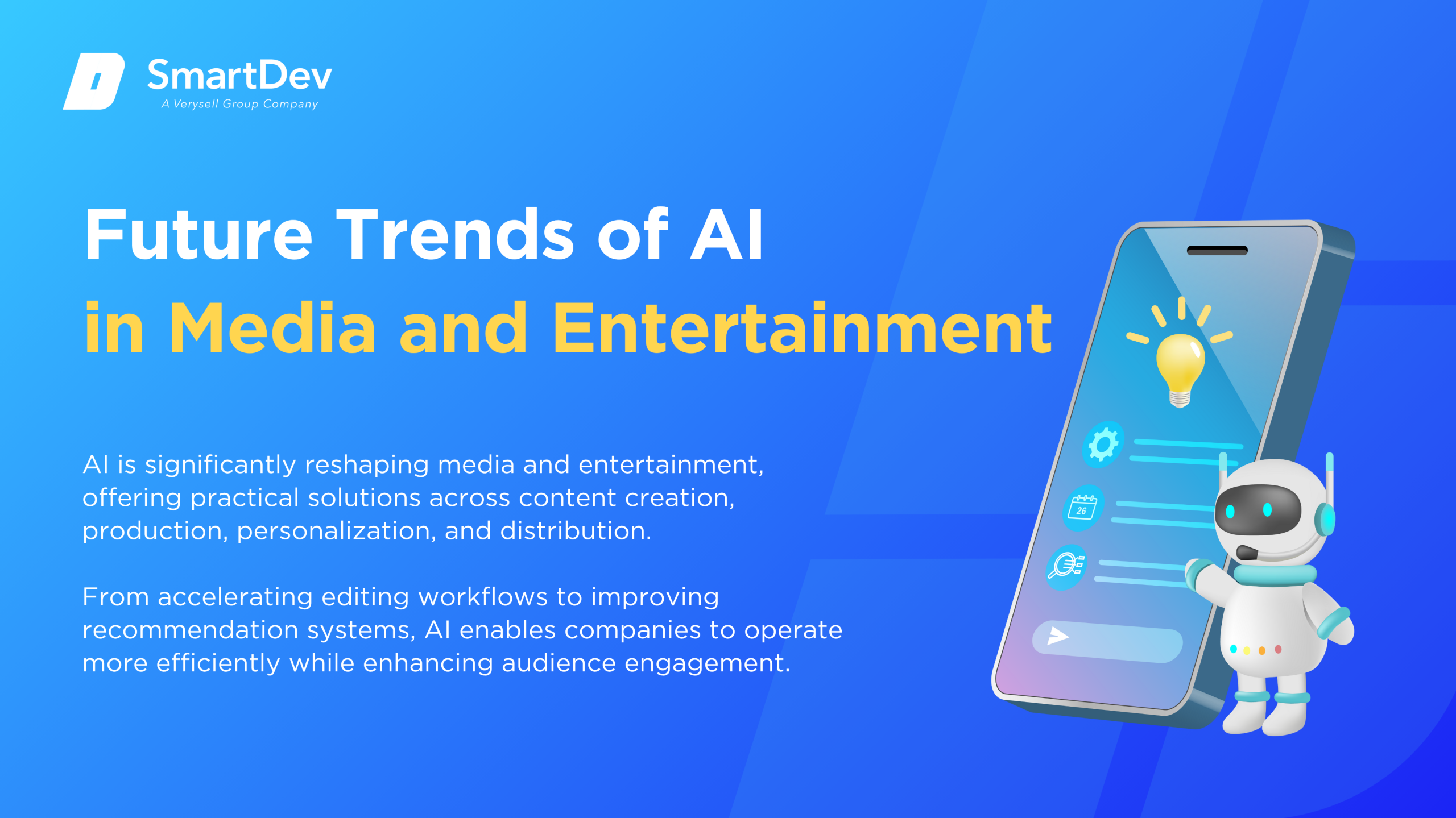
Predictions for the Next Decade
Expect AI to evolve into creative co-pilots capable of scripting, storyboarding, and generating near-finished cuts based on high-level briefs. We’ll see pervasive adoption of digital actors via deepfake and synthetic media, creating new opportunities and ethical challenges.
Personalized storytelling will become mainstream – interactive narratives that adapt in real-time to viewer behavior. Ads will be individually tailored, with thousands of AI-generated variations A/B tested dynamically for each audience segment.
How Businesses Can Stay Ahead of the Curve
To stay ahead, create an agile AI adoption roadmap: continuously pilot new use cases, invest in homegrown AI capabilities, and form partnerships with startups like Moments Lab or Runway. Monitor trends – AI film festivals, generative actor technologies, or deepfake innovations – and enter industry forums to influence IP rules and shape standards.
Most importantly, preserve the human element. Encourage transparent human-AI collaboration in creative workflows, uphold ethical guidelines, and invest in human upskilling to foster a sustainable, creative future.
Conclusion
Key Takeaways
AI is significantly reshaping media and entertainment, offering practical solutions across content creation, production, personalization, and distribution. From accelerating editing workflows to improving recommendation systems, AI enables companies to operate more efficiently while enhancing audience engagement. When supported by reliable data and clear objectives, AI adoption can lead to measurable gains in productivity, quality, and revenue.
However, successful implementation depends on careful planning and alignment with business goals. Organizations must invest in the right tools, develop internal expertise, and ensure cross-functional collaboration. With a strategic approach, AI can become a long-term asset that supports innovation and competitive advantage in an evolving digital landscape.
Moving Forward: A Strategic Approach to AI in Media and Entertainment
As AI continues to reshape the media and entertainment sector, organizations have a unique opportunity to elevate production efficiency, content personalization, and audience engagement. From automating repetitive workflows to enhancing creative output and scaling distribution, AI adoption is quickly becoming a strategic necessity for maintaining competitiveness in an increasingly digital content economy.
At SmartDev, we deliver tailored AI solutions designed to optimize your media workflows, streamline post-production, and drive content performance. Whether you’re exploring generative tools for content creation or intelligent systems for campaign targeting, our team works closely with you to implement technologies that align with your creative and operational goals.
Contact us today today to explore how AI can accelerate your digital transformation and position your organization at the forefront of media innovation.
—
References:
- AI in Media & Entertainment Global Market Report 2025 | The Business Research Company
- GVR Report cover AI In Media & Entertainment Market Size, Share & Trends Analysis Report And Segment Forecasts, 2025 – 2030 | Grand View Research
- AI Utilization In The Media And Entertainment World | Forbes
- 2025 Digital Media Trends: Social platforms are becoming a dominant force in media and entertainment | Deloitte
- Netflix’s Game-Changing Approach: AI in Marketing and Content Creation | The AI Track
- AI in the Film Industry: Scriptwriting to Special Effects | Medium
- Scriptwriting in the Age of AI: Revolutionizing Storytelling with Artificial Intelligence | Journal of Media & Communication (JMC)
- Gen AI and business performance. The results are in | Google Cloud
- 2025 media and entertainment outlook | Deloitte







